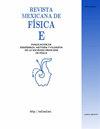A new rolling friction coefficient measurement method based on the work-energy theorem
Q4 Social Sciences
引用次数: 0
Abstract
The rolling friction coefficient represents a characteristic parameter for the rolling motion. To determine the rolling friction coefficient, we propose a simple method based on the conservation of energy. The measuring setup includes the tools and materials that are simple and easy to obtain, such as the spring, ruler, and a small laboratory wheeled cart. In this paper, we have determined the rolling friction coefficient for several masses of the test carts and different lengths of spring compression. When the spring is compressed, its energy is directly proportional to the square of the length of the spring compression. The initial speed of the cart was determined using the law of energy conservation, and the length that the cart goes before stopping is measured with a ruler. The conclusion is that the value of the rolling friction coefficient is usually very small and that the mass of an object will affect the friction force but will not affect the rolling friction coefficient. Besides determining the rolling friction coefficient, this technique should help students comprehend the concept of friction easily.基于功能定理的滚动摩擦系数测量新方法
滚动摩擦系数是滚动运动的一个特征参数。为了确定滚动摩擦系数,我们提出了一种基于能量守恒的简单方法。测量装置包括简单且易于获得的工具和材料,如弹簧,尺子和小型实验室轮式车。本文确定了不同质量的试验车在不同弹簧压缩长度下的滚动摩擦系数。当弹簧被压缩时,其能量与弹簧被压缩长度的平方成正比。用能量守恒定律确定了小车的初始速度,用尺子测量了小车在停车前所走的距离。得出的结论是,滚动摩擦系数的值通常很小,物体的质量会影响摩擦力,但不会影响滚动摩擦系数。除了确定滚动摩擦系数外,该技术还应有助于学生轻松理解摩擦的概念。
本文章由计算机程序翻译,如有差异,请以英文原文为准。
求助全文
约1分钟内获得全文
求助全文
来源期刊

Revista Mexicana De Fisica E
社会科学-科学史与科学哲学
CiteScore
0.80
自引率
0.00%
发文量
14
审稿时长
>12 weeks
期刊介绍:
The Revista Mexicana de Física (Rev. Mex. Fis.) publishes original papers of interest to our readers from the physical science com unity. Language may be English or Spanish, however, given the nature of our readers, English is recommended. Articles are classified as follows:
Research. Articles reporting original results in physical science.
Instrumentation. Articles reporting original contributions on design and construction of scientific instruments. They should present new instruments and techniques oriented to physical science problems solutions. They must also report measurements performed with the described instrument.
Reviews. Critical surveys of specific physical science topics in which recent published information is analyzed and discussed. They should be accessible to physics graduate students and non specialists, and provide valuable bibliography to the specialist.
Comments. Short papers (four pages maximum) that assess critically papers by others authors previously published in the Revista Mexicana de Física. A comment should state clearly to which paper it refers.
 求助内容:
求助内容: 应助结果提醒方式:
应助结果提醒方式:


